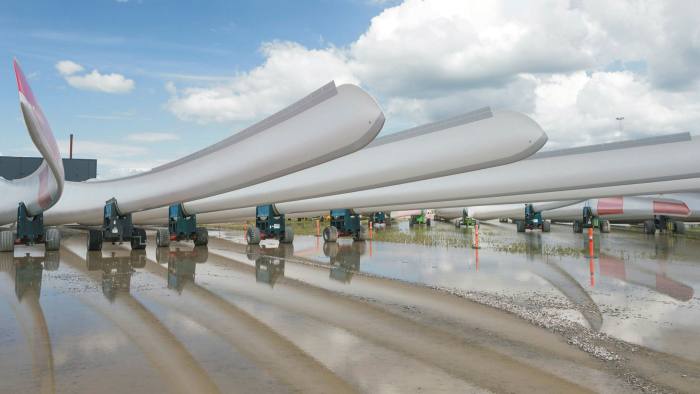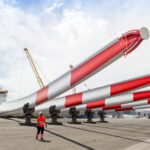Siemens Gamesa has launched what it says is the world’s first wind turbine blade that can be used at a commercial offshore wind farm and recycled at the end of its lifecycle. The company already has agreements with three major customers—including RWE and EDF Renewables—for the installation of the blades at offshore wind farms.
The Zamudio, Spain–based wind turbine manufacturer on Sept. 7 unveiled the RecyclableBlade, an 81-meter (m) long composite blade whose materials can be efficiently separated, reclaimed, and re-used. Siemens Gamesa said it has already produced six RecyclableBlades at its blade factory in Aalborg, Denmark.
The company expects the first deployment of the blades at RWE’s 342-MW Kaskasi offshore wind farm in Germany, a project that is slated to begin operation in 2022. Siemens Gamesa is also working with EDF Renewables “with the aim to deploy several sets of RecyclableBlade at a future offshore wind farm,” it said. Another customer, German firm wpd offshore, has also said it intends to “install sets of the RecyclableBlade at one of their future offshore wind power plants.”
Changing the Paradigm With a ‘New’ Resin
While Siemens Gamea’s freshly unveiled recyclable blade is based on its IntegralBlade technology and follows the same manufacturing process, it applies a “new resin” whose chemical structure makes it possible to efficiently separate the resin from the other components at end of the blade’s working life, the company said.
According to authors of a recent journal article in Energies, most wind turbine blades today are typically cast using glass fibers (GF) and carbon fibers (CF), a core material (like wood or polyethylene terephthalate foam [PET],) and a resin system, which is “most often high-grade epoxy or polyester.” After the resin has cured, all the blade components bind together, becoming “virtually impossible to separate to enable recycling due to the cross-linking that occurs between resin and fibers during curing,” the authors, Ebbe Bagge Paulsen from Siemens Gamesa and Peter Enevoldsen from the Center of Energy Technologies at Aarhus University, explained. While the process significantly contributes to a blade’s structural integrity and flexibility, upon decommissioning, it poses a problematic end-of-life challenge. “The issue of recycling and how to handle waste quantities of the future is a problem area that has been brought to light over the last few years and that is increasingly seeking the attention from the manufacturers and media,” they noted.
While 85% of a wind turbine is already recyclable, it has so far proven “inherently difficult” to recycle their blades in a cost-efficient way, which is why wind farm owners have mostly disposed blades as landfill, Siemens Gamesa said on Tuesday. However, several European countries have introduced bans on the use of fiber-reinforced composite (FRP) in landfills. “As the number of installations and turbine sizes continue to increase it becomes even more important to reduce the amount of waste and to reuse and recycle all parts to achieve a green future,” it said.
Siemens Gamesa suggests that at the end of a wind turbine’s life, the RecyclableBlade will be dismantled and “prepared for the recycling process.” It will then be immersed in a “heated mild acidic solution, which will separate the resin from the fiberglass, plastic, wood, and metals.” The “mild process” protects the properties of the materials in the blade, in contrast to other existing ways of recycling conventional wind turbine blades, it said. Once separated, the materials can then be recovered from the solution and prepared for secondary use via rinsing and drying.
According to Siemens Gamesa, recovered materials from RecyclableBlades would be used in new products that “match” the technical properties of the materials. Use cases could include “the automotive industry, or in consumer goods like flight cases and flatscreen casings,” it said.

Why Blade Recycling Has Been So Far Elusive
POWER has reached out for more details about Siemens Gamesa’s new resin, and it has asked about the composition of the RecyclableBlade, and the added costs related to the recycling process. Responses will be posted here when they are received.
As POWER has reported, several other wind turbine manufacturers are also looking into wind turbine blade recycling via similar approaches. GE this February, for example, unveiled a project with Oak Ridge National Laboratory and the National Renewable Energy Lab that will focus on a “low-cost thermoplastic skin coupled with printed reinforcement.” The project’s emphasis on thermoplastics is notable because the emerging material could boost efforts to make wind turbine blades recyclable.
And in May, a coalition of wind industry and academic leaders—including wind turbine manufacturer Vestas, chlor-alkali leader Olin Corp., Aarhus University, and the Danish Technological Institute—launched a new initiative, Circular Economy for Thermosets Epoxy Composites (CETEC), to commercialize a thermoset epoxy composite material within three years. Developed with funding from the Danish government, the material is manufactured under a two-step process. First, “thermoset composites are disassembled into fiber and epoxy. Secondly, through a novel chemcycling process, the epoxy is further broken up into base components similar to virgin materials,” the companies said. “These materials can then be reintroduced into the manufacturing of new turbine blades, constituting a new circularity pathway for epoxy resin.”
But as Paulsen and Enevoldsen highlight in their article, the varying materials and approaches pose different challenges. Current wind turbine blade recycling methods they surveyed include:
Mechanical Recycling. This approach generally uses mechanical shredders to divide the composite material into smaller parts and pieces. “The output of mechanical recycling can be used, among other options, as fillers, reinforcements or as raw material to produce new plastic products or for the production of cement, which means that the output can be divided into two categories: utilization of materials and co-processing,” they note. At least one study has suggested, however, that using shredded composite waste from end-of-life blades would be limited because the “mechanical properties of the waste composites deteriorated drastically when exposed to the mechanical recycling method.”
Thermal Recycling. Typically involving pyrolysis and microwave pyrolysis, this approach relies on heating the material to break down the resin into lower-weight molecules. “Since [end-of-life blades] mainly contain GF and epoxy resin, temperature above 500–550C will be required to decompose the epoxy, resulting in residual GFs with more than 50% weakened material properties compared to virgin fibers,” the authors said. Pyrolysis, however, is better suited for the recycling of CF, which is more resistant to high temperatures.
Chemical Recycling. This approach relies on a solvent “composed of catalysts/additives” (like alcohols, water, glycols, or ketones) to depolymerize the chemical cross-linked bond present in thermoset polymer products, the authors said. The most prevalent method, solvolysis, typically uses a reactive solvent in combination with temperature and pressure to diffuse into the composite material and break specific bonds in the resin. However, chemical methods are considered more dangerous because potentially hazardous substances would be used. That would add to the cost of setting up an industrial-level chemical FRP waste recycling site “because it is an expensive and technologically complex process,” the authors said.
—Sonal Patel is a POWER senior associate editor (@sonalcpatel, @POWERmagazine).










